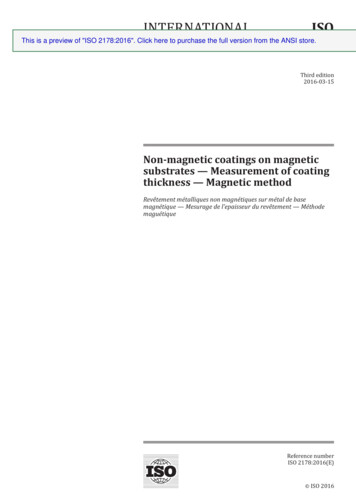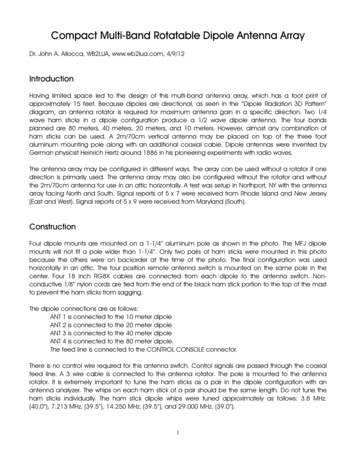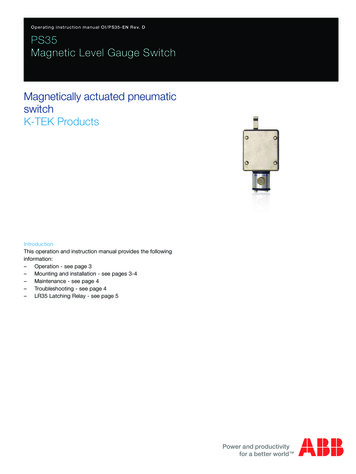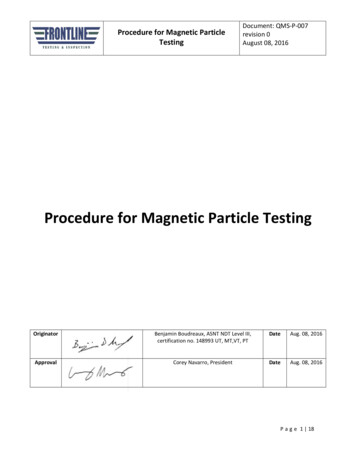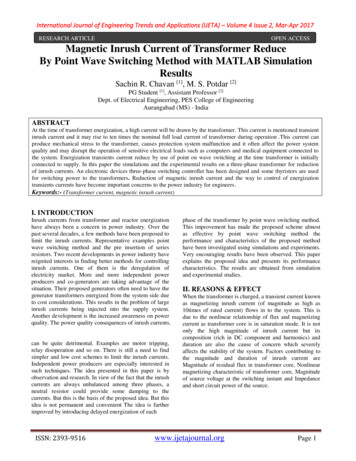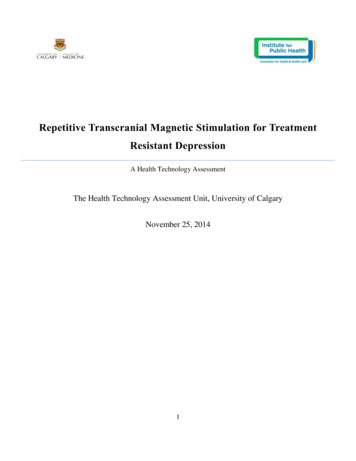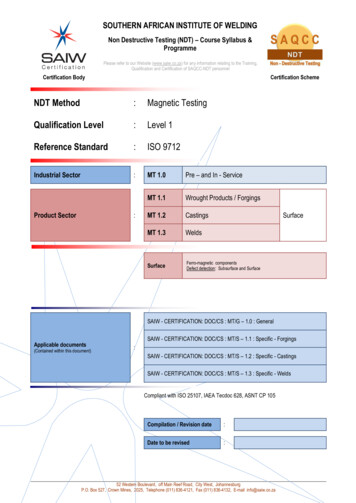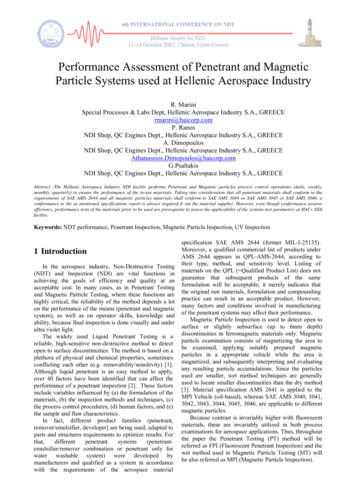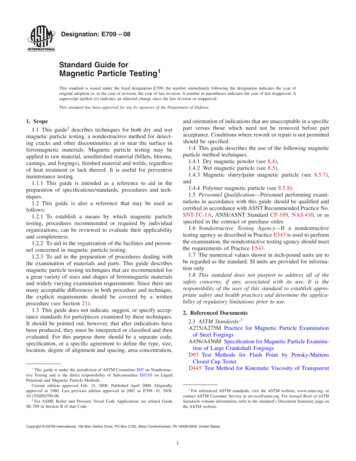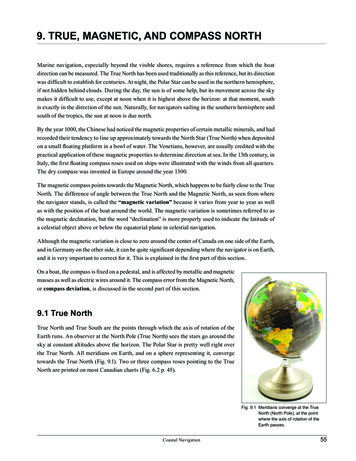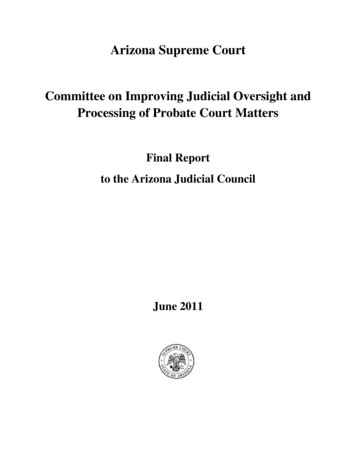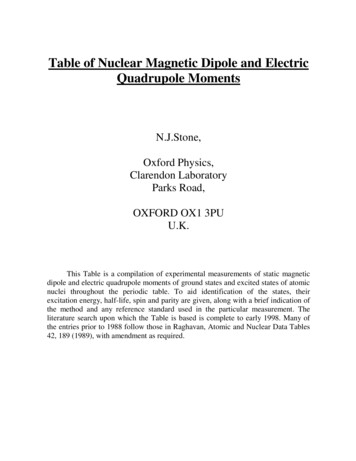
Transcription
Table of Nuclear Magnetic Dipole and ElectricQuadrupole MomentsN.J.Stone,Oxford Physics,Clarendon LaboratoryParks Road,OXFORD OX1 3PUU.K.This Table is a compilation of experimental measurements of static magneticdipole and electric quadrupole moments of ground states and excited states of atomicnuclei throughout the periodic table. To aid identification of the states, theirexcitation energy, half-life, spin and parity are given, along with a brief indication ofthe method and any reference standard used in the particular measurement. Theliterature search upon which the Table is based is complete to early 1998. Many ofthe entries prior to 1988 follow those in Raghavan, Atomic and Nuclear Data Tables42, 189 (1989), with amendment as required.
CONTENTSGeneral IntroductionPoliciesArrangement of the TableList of annotationsList of Experimental Method abbreviations usedLiterature Reference abbreviation list113******General IntroductionThis Table comprises a listing of measured magnetic dipole and electric quadrupole moments ofground states and excited states of atomic nuclei. Results obtained by all experimental methods areincluded and the literature search covers the period approximately up to the end of 1998. The Tableincludes many listings from the most recent previous compilation [1], mainly without changes, butamended where appropriate. To assist in definitive identification of the nuclear state involved, thetable includes the energy (in keV), half-life, and spin/parity of the state, taken either from theauthors or from recent compilations. The Table follows its predecessors in listing also any referenceisotope and state used to deduce the quoted moment from experiment. The method used in theexperiment is given, although for all details of the method reference should be made to the originalpublication. References are given are given both in the ENSDF format [for use with the NNDCNuclear Data compilation] and to the journal. Listings of abbreviations used to identify methodsand journals are given later in this introduction. Some common comments on the results are madeby abbreviations given next to the Table entry. The abbreviations used for these comments are alsolisted in this introduction.POLICIESSigns Signs are given when the sign can be determined from experimental data. Where the sign isnot given by the measurement, no sign is given in the Table, although it can often be inferred eitherfrom systematics or from the magnitude of the result.Results and UncertaintiesExperimental values and their associated errors are as given by theauthors subject to a policy of limiting significant figures. Numerical errors with digits above 15have been rounded to 2 and results have been rounded to give no more significant figures than therounded error would allow. Thus a published value 0.953(65) has been rounded to 0.95(7) and0.25(16) rounded to 0.3(2).Magnetic Dipole Moments (m)The fundamental reference is to the adopted proton moment 2.79284734(3) nuclear magnetons (nm), after diamagnetic correction, based on the most recentrecommended values for physical constants [2]. This has been revised downward since the lastcompilation [1] by 0.018 ppm. Other subsidiary dipole moment standards are set using highprecision experimental ratios of nuclear magnetic resonance frequencies for heavier stable nuclei
11B, 14N, 35Cl, 45Sc, 111Cd, and from optical pumping frequency for 199Hg, compared to that of theproton or deuteron. References to these are given where they appear in the Table.Corrections for diamagnetism, Knight shift, paramagnetism and hyperfine anomaly arenoted by annotations d, K, p, or ha respectively after the entry when they have been taken intoconsideration by authors, either by explicit corrections or by allowance in quoted uncertainties.The diamagnetic correction merits further comment. This correction is applicable under anycircumstance that a magnetic field is applied to the nucleus under study and the nucleus is situatedin a medium subject to diamagnetism - that is all media other than vacuum. Diamagnetismdescribes the polarisation of the medium whereby the field as experienced by the nucleus isreduced. This effect leads to a reduction in the magnetic dipole interaction energy and an apparentreduction in the nuclear magnetic dipole moment if the full applied magnetic field strength is used.Many experimental methods use 'internal' or 'transient' fields produced by electrons in thevicinity of the nucleus. Such internal fields are determined through their measured interactionenergy with nuclei having known magnetic dipole moments. They are not subject to diamagneticcorrection, although they do require correction for any hyperfine anomaly between the isotope usedfor calibrating the field and the isotope under study [4]. Of course, if there is any additional externalapplied field used then this component of the total field at the nucleus is subject to the diamagneticcorrection.Several previous tabulation compilers have apparently applied diamagnetic corrections andhave included listings of diamagnetic correction factors due to Johnson and co-workers [3]. Itshould be stressed that the tabulated corrections apply only to neutral atoms, assumed spherical,and are not generally applicable e.g. to nuclei implanted into planar non-magnetic foils and subjectto applied magnetic fields. All recent [post 1989] entries in the Table are unmodified publishedvalues.Electric Quadrupole Moments (Q). These are listed in units of barns (1 b 10-28 m2). Correctionsrelating to electric field gradient shielding caused by polarisation of atomic electrons, normallyknown as Sternheimer Corrections, are indicated by the annotation st after the entry. TheSternheimer correction, which can be positive (shielding) or negative (anti-shielding) and can belarge, is difficult to calculate with high accuracy, even for different states of the same atom or ion.It is the cause of several apparently large discrepancies between reported, uncorrected, electricquadrupole moments listed in the Table.Where two values of Q are given based on CER experiments, the first represents the valueassuming constructive interference between the matrix elements and the second assumesdestructive interference.
Arrangement of the TableThe table is set up with ten columns giving information as follows:Column 1.Identifies the nucleus by atomic number Z and neutron number N, with its chemicalsymbol. This is given once for each nucleus. Nuclei are grouped by element in increasing sequenceof atomic number and by increasing neutron number for each element.Column 2.Gives the energy of the state on which the measurement is made, rounded to thenearest keV, 0 being the ground state.Column 3.Gives the half-life of the state: abbreviations used y years, d days, h hours, m minutes, s seconds, ms milliseconds (10-3 s), ms microseconds (10-6 s), ns nanoseconds(10-9 s), ps picoseconds (10-12 s) and fs femtoseconds (10-15 s).Column 4.Gives the spin (I) and parity of the state. Uncertain values are given in brackets.Column 5*. Gives the measured nuclear magnetic dipole moment m in units of the nuclearmagneton mN (nm). No sign is given if it was not determined by the experiment. The uncertainty inthe result is given in brackets, subject to the policy declared in the introduction. Thus 1.432(8)means a value of 1.432 nm with uncertainty 0.008 nm and of unknown sign. In some cases, wherethe spin of the level is unknown, the nuclear g-factor, g m/I is given. Where several states wereunresolved, the average g-factor is given as gav.Column 6*. Gives the measured nuclear electric quadrupole moment in units of the barn (1 barn 10-28 m2). No sign is given if it was not determined by the experiment. The uncertainty in theresult is given in brackets, subject to the policy declared in the introduction. Thus 1.27(10) meansa value of 1.27 barns with uncertainty 0.10 barns.Column 7.In this column any reference standard upon which the listed result depends is given.Often the reference state has been used to obtain the value of a static magnetic hyperfine field, atransient field or an electric filed gradient which is then used to determine the quoted result. Anysubsequent change in the value of the standard will affect the listed result.Column 8The method used in the measurement is briefly identified here. A list ofabbreviations used follows this description of the Table. In view of the great proliferation ofspecialised methods, this simple description is very limited and for detailed information referenceshould be made to the original publication. Where there has been re-evaluation by the tabulator ofthe original result, usually associated with change to the reference standard, this is denoted by R.Column 9.Here is given the NSR reference where known.Column 10. Here the Journal reference to the original work is given, generally in the formjournal (abbreviated), volume, page and year (last two digits, in brackets). A list of journalabbreviations and other abbreviations used is given below.* Certain entries have additional annotations relating to whether or not specific corrections havebeen made. These annotations are discussed under the magnetic dipole moment and electricquadrupole moment sections of the policies given above.
List of Annotations and Abbreviations in the Tableadg.s.hK#Requires no Sternheimer correction.Corrected for diamagnetism.Ground State.This result uses an uncertain hyperfine field. Given error is experimental only.Corrected for Knight shift.This result uses an estimated hyperfine field with no error given.Experimental Reference AbbreviationsABAtomic Beam Magnetic Resonance - Thermal BeamAB/DAtomic Beam Magnetic Resonance (direct moment measurement)ABLDFAtomic Beam with Laser Double Resonance DetectionABLFSAtomic Beam with Laser Fluorescence SpectroscopyABLSAtomic Beam Laser Spectroscopyb-NMRNMR of in-beam polarised nuclei with beta asymmetry detectionb-NMR/OP NMR of nuclei polarised by optical pumping with beta asymmetry detectionb-NNQRNuclear Quadrupole Resonance with beta detectionB(E2)Value based on measured E2 transition probabilityBFNOBrute Force Nuclear OrientationBFNMR/ON Nuclear Magnetic Resonance on Brute Force Oriented NucleiCDPACConstant-Delay Perturbed Angular CorrelationCEADIntegral Perturbed Angular Distribution after Coulomb ExcitationCERCoulomb Excitation ReorientationCERPPrecession of Coulomb Excitation ReorientationCETDTDPAD following Coulomb ExcitationCFBLSCollinear Fast Beam Laser Spectroscopy - Accelerated BeamCFBLS/ b-NMRCollinear Fast Beam Laser Spectroscopy: NMR with beta detectionCIANCoulomb Interaction of Aligned NucleiENDORElectron-nuclear Double ResonanceEPRElectron Paramagnetic ResonanceESElectron ScatteringFDPACTime Differential Perturbed Angular Correlation of Fission FragmentsFortPFortschrift PhysikIAPADIntegral Attenuation of Perturbed Angular DistributionIBSQBQuantum Beats after Surface Interaction at Grazing IncidenceIPACIntegral Perturbed Angular CorrelationIPADIntegral Perturbed Angular DistributionIMPACPerturbed Angular Correlation after Ion ImplantationIMPADPerturbed Angular Distribution after Ion ImplantationKa-XKaonic X-ray Hyperfine StructureLEMSLevel Mixing Spectroscopy
LLevel Mixing Resonance on Oriented NucleiLaser RF Double Resonance SpectroscopyLaser Resonance Fluorescence SpectroscopyLaser Resonance Ionisation Mass SpectroscopyLaser Resonance IonisatioLaser Resonance SpectroscopyLaser Resonance Specroscopy with Radioactive DetectionMicrowave Absorption in gasesMultiple Adiabatic Passage NMR on Oriented NucleiMolecular Beam Magnetic ResonanceMulticonfigurational Hartree Foch calculated efg's used to extract QMossbauer EffectMaser/Nuclear Magnetic Resonance frequency comparisonMolecular SpectroscopyMuonic X-ray Hyperfine StructureNuclear Magnetic ResonanceNuclear Magnetic ResonanceNuclear Magnetic Resonance detected using the Mossbauer EffectNuclear Magnetic Resonance on Oriented NucleiNuclear Magnetic Resonance on Oriented Nuclei with beta detectionNuclear Magnetic Resonance on Oriented Nuclei with X-ray detectionNuclear Magnetic Resonance detected using Angular CorrelationGamma Circular Polarisation measured from Oriented NucleiMossbauer Effect on Oriented NucleiNMR detected using Optically Pumped IonsStatic Nuclear Orientation with gamma detectionStatic Nuclear Orientation with beta detectionDynamic Nuclear OrientationOptical SpectroscopyOptical Double ResonanceOptogalvanic Laser SpectroscopyOptical Level CrossingOptical Pumping with NMR using beta detectionOptical Pumping with Radiative DetectionPion Photoproduction near thresholdPionic X-ray Hyperfine StructureParamagnetic ResonancePerturbed Polarisation-Directional Angular CorrelationsProton Pick-up Reaction: Spectroscopic FactorsQuadrupole ResonanceQuadrupole Interaction deduced from Relaxation TimeRe-evaluated by tabulator, usually because of change in reference standardReorientation Nuclear OrientationRecoil into gas or vacuumRecoil into Vacuum, Differential methodStroboscopic Observation of Perturbed Angular DistributionTime Dependent Perturbed Angular CorrelationTime Dependent Perturbed Angular DistributionTransient Field integral perturbed angular correlationTilted Foil hyperfine field integral perturbed angular correlation
TFLDTISTR/OLNOTilted Foil Time Differential Perturbed Gamma Angular DistributionTrapped Ion SpectroscopyTime Resolved On-Line Nuclear OrientationLiterature Reference ARRoARTITARWaAuJPBAPSBk64PACBk82HFSBk86LTNOBk88 Cf76CargCf77TokyoCf77Tshkt
the method and any reference standard used in the particular measurement. The literature search upon which the Table is based is complete to early 1998. Many of the entries prior to 1988 follow those in Raghavan, Atomic and Nuclear Data Tables 42, 189 (1989), with amendment as required. CONTENTS General Introduction 1 Policies 1 Arrangement of the Table 3 List of annotations ** List of .
